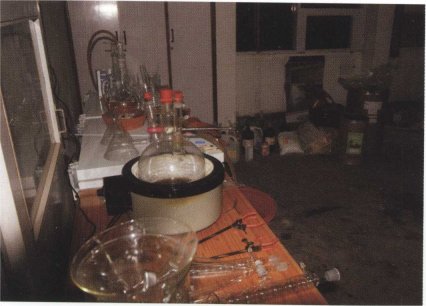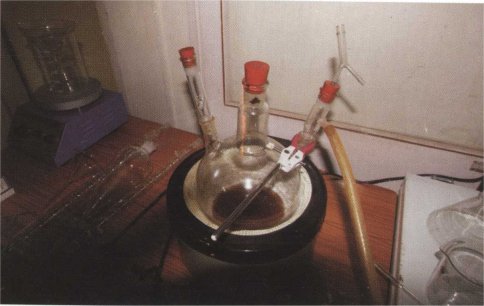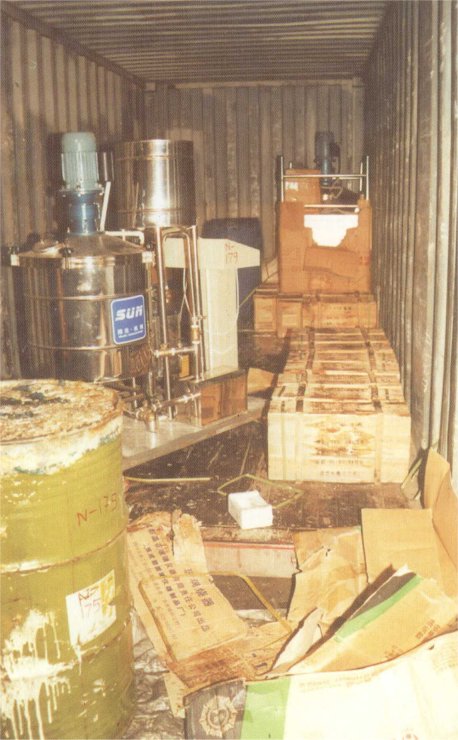Illicit Methamphetamine Labs
| Reports - Narcotics Control Bureau India Annual Report 2006 |
Drug Abuse
Illicit Methamphetamine Labs
A variety of synthetic substances are known to have psychotropic properties and are susceptible to be abused, much like many naturally produced drugs.
The production of synthetic drugs has several obvious advantages over drugs obtained from botanical sources. Unlike plants, which have a considerable growing and maturing period, chemical processes can be completed in much shorter time frames. Natural drugs require to be planted on land, which is an expensive resource. Being in the open, such plantations are also more vulnerable to detection. Synthetic processes on the other hand can be carried out in enclosed spaces, which may even be makeshift laboratories in garages or 'kitchen labs' operating in multi-storied buildings. Botanical drugs have associated with them large amounts of bio-mass, which enhances the risk of exposure. The synthetic production of drugs often produces substantial quantities of chemical waste, which may be hazardous to the environment, but which is not a significant risk for exposure. Synthetic drugs additionally have the advantage that they can be produced in or near consumption areas.
The term amphetamine-type stimulants (ATS) generally encompasses amphetamines (amphetamine and methamphetamine), MDMA (ecstasy or XTC) and other synthetic stimulants like methacathinone. These psychotropic substances are synthesized from various chemicals, which have licit industrial or medicinal uses. The main precursor chemicals are 1- Phenyl-2-Propanone (or P2P or BMK), ephedrine and pseudoephedrine (for amphetamine and methamphetamine) and PMK (for MDMA / ecstasy). Other chemical substances are also required as reducing agents and solvents, while acids are required for producing salts. Most of such chemicals can be obtained from available commercial outlets. No highly specialized scientific glassware or equipment is required. Laboratory glassware can even be replaced with household items, while other equipment can be improvised or made to order.
The United Nations Office on Drugs and Crime (UNODC) estimated that, during the year 2005, the worldwide production of ATS was 480 tons, of which methamphetamine was 278 tons, amphetamine was 88 tons and ecstasy was 113 tons. The UNODC estimates that ATS production increased throughout the 1980s and dropped off slightly after peaking in the year 2000. It again increased in 2004-2005. The main production areas of ATS lately remained concentrated in North America, East and Southeast Asia and Europe. Most of the ecstasy production took place in Europe, notably the Netherlands. Methamphetamine production was more marked in North America and South East Asia. The number of ATS laboratories dismantled throughout the world were about 550 in 1990. These increased to around 7,000 in the year 2000 and a record number of 18,532 laboratories were dismantled in the year 2004. An overwhelming majority (96%) of the dismantled ATS laboratories were producing methamphetamines. Almost 97% of the facilities dismantled were in the USA and, to a lesser extent, in Mexico. The number of illicit laboratotries dismantled in the year 2005 were 13,438.
During the year 2006, three attempts to set up illicit methamphetamines laboratories in India were thwarted.
In the month of October 2006, an illicit lab was busted in Gurgaon, near Delhi, which had been set up by foreign nationals. The first cycle for processing ATS had been commenced after hiring the premises and procuring a large variety of laboratory equipment and chemicals. Six Hong Kong Chinese and one Canadian of Indian origin were arrested in the case.


Equipment seized from the illicit methamphetamine lab busted in Gurgaon
In the month of November 2006, after prolonged surveillance on the activities of certain suspects, two persons and a container which had been imported into the country were intercepted in Kolkata. The container yielded laboratory equipment and chemicals which had been imported in preparation of setting up an illicit methamphetamine laboratory in Delhi. Two persons were arrested in the case.


Lab equipment seized from a container in Kolkata
The activities of yet another group of Hong Kong and Indian nationals were kept under prolonged surveillance in Mumbai for several months. Though the group managed to hire premises and make other preparations for establishing a meth lab, they could not acquire any ephedrine or any other controlled substance for the manufacture of ATS. Members of the group later fled, apprehending arrest.
| < Prev | Next > |
|---|












